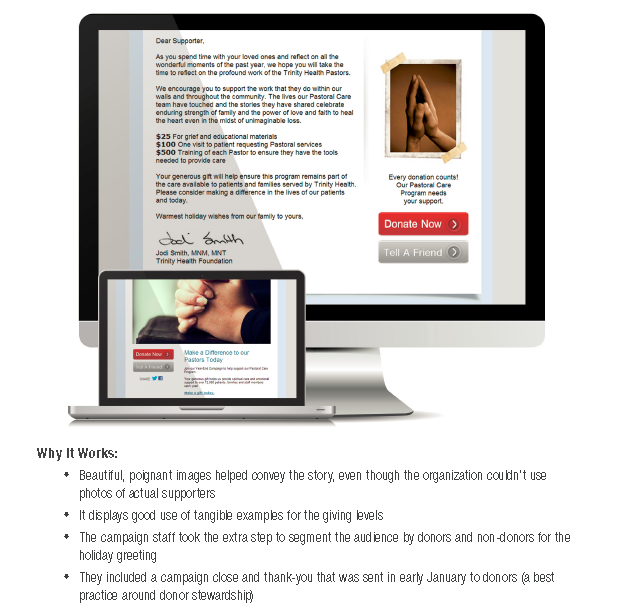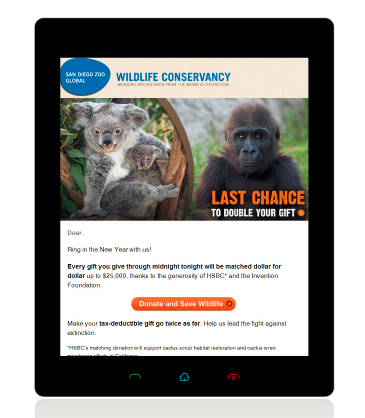by Lindsay Salmony, Blackbaud, Inc.
With the season of giving just around the corner, it’s crucial that your organization is prepared to capitalize on the generosity of your donors and potential donors. A well-crafted fundraising appeal is the integral piece to your year-end ask. With this in mind, here is the strategy and steps to crafting an ask that brings in more money to your organization. [And if you want to really step-up your game, take a look at the new eBook about writing and designing fundraising appeals that work!]
Before You Pick Up Your Pen: Creating a Plan
Successful writing begins with a good plan. Make sure you know the short answer to WHY you’re writing an appeal letter— your letter’s content will be better off because of it. Of course, your primary answer for why you are writing to your constituents should be, “Because I want them to respond.”
So, what inspires and motivates people to respond?
Research shows that donors give because they feel connected to an organization’s vision and mission, they want to help others, or they want to make a difference in their communities by giving back. But if you’re sending appeals to new prospects who don’t know much about your organization, you can’t depend on these factors to motivate them to give. That’s why it’s important to treat your appeal like it’s any other piece of direct mail, which needs to be especially enticing to get a response.
Direct marketing professionals say that the top motivating factors that get people to take action are guilt, fear, exclusivity, greed, and anger. But how can you weave these motivations into your letter and ensure that they apply appropriately?
Here are a few tips:
- Make sure to give readers the opportunity to feel an emotional connection so they are compelled to help. (Motivating factor: guilt)
- Write in a way that makes the reader feel singled out. (Motivating factor: guilt)
- Illustrate the consequences of NOT contributing to your cause. (Motivating factor: fear)
- Ensure that the tone of your letter is friendly and engaging so readers feel like they know you. (Motivating factor: exclusivity)
- Mention the recognition they’ll get. (Motivating factor: exclusivity & greed)
- Give them something tangible in return. (Motivating factor: greed)
When you set out to apply any of these techniques, make sure not to go overboard. While these emotions can inspire action, they can also serve to alienate your readers if they seem too threatening. Americans need positive messages, especially today.
Example: If your organization’s mission revolves around serving food to the needy, a sentence like, “Without your help, 800 citizens in this area will go hungry in 2010” sounds dire and threatening.
Try this instead: “In 2009, our organization distributed 12,000 fresh meals to people in need. For many of these disadvantaged citizens, it meant they wouldn’t have to choose between paying their heating bills and purchasing food to fill their stomachs. With your help, we hope to double the number of meals we distribute in 2010.”
Not only is the re-written message stronger because it’s more positive, but it also paints a better picture of the need. Blandly reciting facts and figures (“800 citizens will go hungry”) doesn’t truly illustrate the problem your organization is trying to remedy. When you tell a story, even a short one, (in this case, we told a story about how hungry people sometimes have to choose between paying bills and purchasing food) the reader will be able to better identify with the situation and make an emotional connection.
Before you begin writing your appeal, gather testimonials from the people you serve. You can also come up with a tangible story by thinking about how your organization’s services impact the community and ask yourself, “But what does that really mean?”
Putting Ink to Paper: Tips for Writing Effectively
A first impression can make or break your email. Along with crafting a compelling subject line, your first paragraph should include motivational language (as mentioned above) as well as the one thing you want your reader to remember.
Writers call this the “one-sentence takeaway,” or the single most important thing that needs to be communicated. Think of it as the only sentence your supporters will read before making the decision of whether or not to move your email to the trash. Make sure your one-sentence takeaway is clearly written and stated at the beginning of your email.
Make sure to avoid using the passive voice and write to your supporters as if you are having a one-on-one conversation. Use action verbs, avoid lengthy words and sentences, and use the words “I” and “you.” These are easy ways to ensure your readers will make a connection with you.
Be explicit in your “ask.” Don’t hope that readers will understand what you’re asking for. Make it clear, and repeat it as often as you can. For example, write, “By making a tax-deductible donation, you can help.” and then repeat with a variation like, “Join this important cause by making a one-time or recurring donation.”
Trinity Health Foundation’s end of year appeal email used specific giving levels to encourage EOY gifts:

*And always mention that there is a tax benefit to donating to your cause. For many donors, this is one of the most motivating factors.
Beyond the Copy: Other Important Elements
The content of your letter is extremely important. But equally as important as your copy is your appeal’s design.
Hint: Think Mobile.
In November 2013, 51% of all emails were opened on mobile devices, according to Litmus. When thinking about your email visual design, mobile rendering needs to be the priority.
Here are two ways to design mobile-friendly emails:
- Responsive Email Design: This automatically detects the device being used and reformats the email. The goal here is to provide the best user experience, regardless of device.
- Mobile-Friendly Email Design: If you’re not using a responsive design email, you can make your email mobile-friendly by using a simple layout, narrower email width, compelling mobile-friendly images, scannable content, and BIG buttons.
We really love how Wildlife Conservancy designed their appeal:

Last and most importantly, make it easy to donate.
If you leave out this critical step, you might never get the results you want, even if you’ve gotten your constituents to open your email and read the content thoroughly.
Download the eBook for more step by step guidance to craft your next appeal!
About the author: Lindsey Salmony works on Blackbaud’s Corporate Marketing team as a program manager, writer, editor, and graphic designer. Before joining Blackbaud, she worked at several newspapers as a reporter, writing news stories and in-depth feature articles. Lindsey also worked as a graphic designer at the Publications Department for the University of Colorado at Boulder, where she graduated with a degree in news editing/journalism. Currently, Lindsey is a board member for Charleston-based nonprofit Fields to Families, helping them manage their marketing and communications projects.
Post originally appeared on npEngage by Blackbaud
